7.2 Crystallization of Magma
The rock cycle—in spite of being referred to as a cycle—can be said to have a starting point. All of the rock that’s undergoing processes within the rock cycle originated from magma that formed due to partial melting of mantle rocks. Mantle rocks are ultramafic in composition, meaning they’re very high in iron and magnesium, and relatively low in silica. In spite of ultramafic rocks being the starting point, ultramafic magma is not encountered in modern volcanic environments, and ultramafic rocks are relatively rare at Earth’s surface.
Partial melting is part of the reason we no longer see ultramafic magmas and lavas. Earth just isn’t hot enough to melt the highest-temperature minerals in the mantle. Ultramafic volcanic rocks—called komatiites—exist, but with two notable exceptions, the youngest of these is 2 billion years old, from a time early in Earth’s history when it was much hotter.[1]
Partial melting of mantle rocks means that even magmas derived directly from the mantle are already a slightly different composition, in the same way that the partial melting experiment in Figure 7.3 resulted in a melt that included only two of the four components in the original mixture. In the case of silicate minerals, those with more silica will melt before those with less silica. Quarts and feldspar, for example, are the “candle wax” of partial melting. Biotite is the plastic pipe. This means the partial melt will have more silica than the original rock taken as a whole.
Partial melting is a way to affect the composition of an igneous rock during the melting stage, but there are a number of processes that affect the composition as melted rock moves within Earth and cools. These include:
- Mixing in of magma of a different composition, including from rocks melted by heat from the original magma.
- Fractional crystallization, when minerals with a higher melting point crystallizing early in the cooling process and settling out of the magma.
- A series of chemical reactions called Bowen’s reaction series that happen as the melt cools.
Compositional Categories
Before we talk about how we get igneous rocks of different compositions, we need to cover the terms used to describe the general compositional categories. These terms are used frequently when discussing igneous rocks and volcanic processes, so it’s important to know them. In order of increasing silica content after the ultramafic category are mafic, intermediate, then felsic (Figure 7.6).
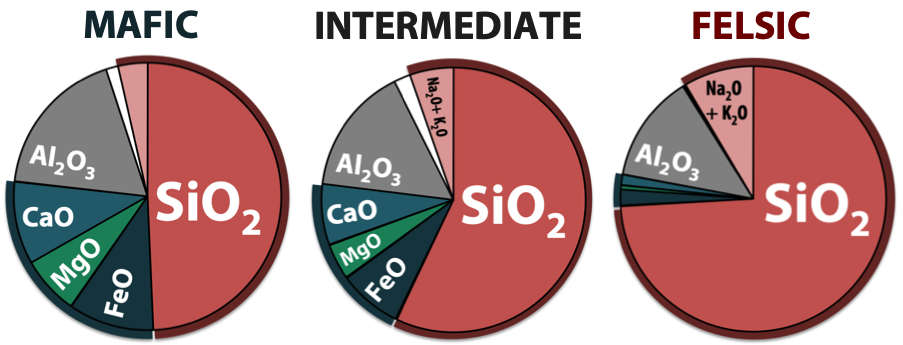
Magma compositions are reported in terms of the fraction of mass of oxides (e.g., Al2O3 rather than just Al). On average, mafic magmas are approximately half SiO2 (45% to 55%), about 25% FeO, MgO, and CaO combined. They have about 5% Na2O + K2O. Felsic magmas, on the other hand, have much more SiO2 (65% to 75%) and Na2O + K2O (around 10%) and much less FeO, MgO, and CaO (about 5% combined). Magmas that fall between mafic and felsic magmas have an intermediate composition.
Quick Check
Can you fill in the missing words to complete these statements about magma compositional categories?
magmas are characterized by minerals with MAgnesium and FerrIC (containing iron) components, such as olivine and pyroxene.
magmas have minerals like potassium FELdspar and quartz, which are more SIliCa-rich.
To check your answers, navigate to the below link to view the interactive version of this activity.
Bowen’s Reaction Series
The minerals that make up igneous rocks crystallize (solidify, freeze) at a range of different temperatures. This explains why cooling magma can have some crystals within it and yet remain predominantly liquid. The sequence in which minerals crystallize from a magma as it cools is known as Bowen’s reaction series (Figure 7.7).
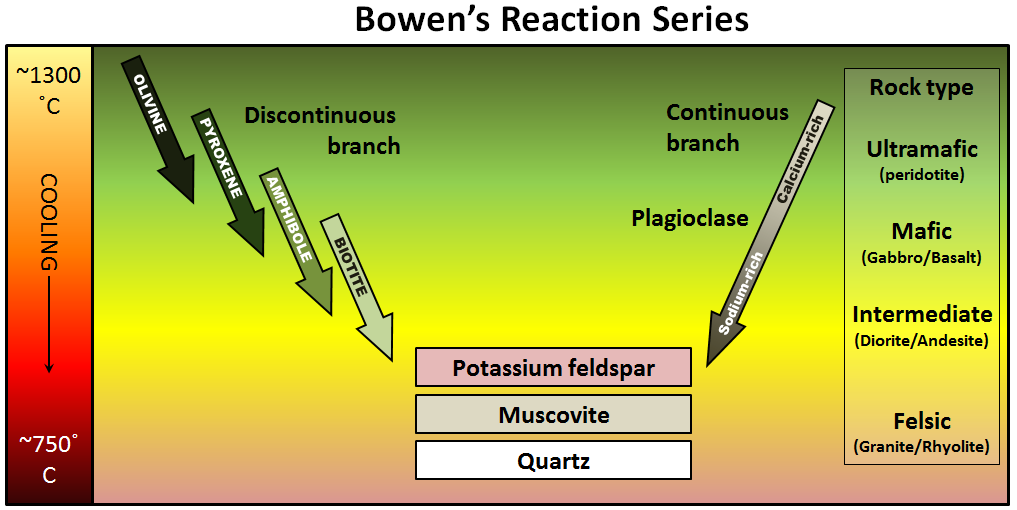
How Did We Get Bowen’s Reaction Series?
Understanding how the reaction series was derived is key to understanding what it means.

Norman Levi Bowen (Figure 7.8) was born in Kingston Ontario. He studied geology at Queen’s University and then at Massachusetts Institute of Technology. In 1912 he joined the Carnegie Institution in Washington, D.C., where he carried out ground-breaking experiments into how magma cools.
Working mostly with mafic magmas, he determined the order of crystallization of minerals as temperature drops. First, he melted the rock completely in a specially-made kiln. Then he allowed it to cool slowly to a specific temperature before quenching (cooling it quickly) so that no new minerals could form. The rocks that formed were studied under the microscope and analyzed chemically. This was done over and over, each time allowing the magma to cool to a lower temperature before quenching.
The result of these experiments was the reaction series that—even a century later—is still an important basis for our understanding of igneous rocks.
Discontinuous and Continuous Series
Bowen’s reaction series (Figure 7.7) has two pathways for minerals to form as magma cools: on the left is the discontinuous series. This refers to the fact that one mineral is transformed into a different mineral through chemical reactions. On the right is the continuous series, where plagioclase feldspar goes from being rich in calcium to being rich in sodium.
Continuous Series
At about the point where pyroxene begins to crystallize, plagioclase feldspar also begins to crystallize. At that temperature, the plagioclase is calcium-rich (toward the anorthite end-member). As the temperature drops—and providing that there’s sodium left in the magma—the plagioclase that forms is a more sodium-rich variety (toward the albite end-member). The series is continuous because the mineral is always plagioclase feldspar, but the series involves a transition from calcium-rich to sodium-rich.
When cooling happens relatively quickly, instead of getting crystals of uniform composition, individual plagioclase crystals can be zoned. This means they have concentric layers that go from calcium-rich in the centre to more sodium-rich around the outside (Figure 7.9). This occurs because calcium-rich early-forming plagioclase crystals become coated with progressively more sodium-rich plagioclase as the magma cools.
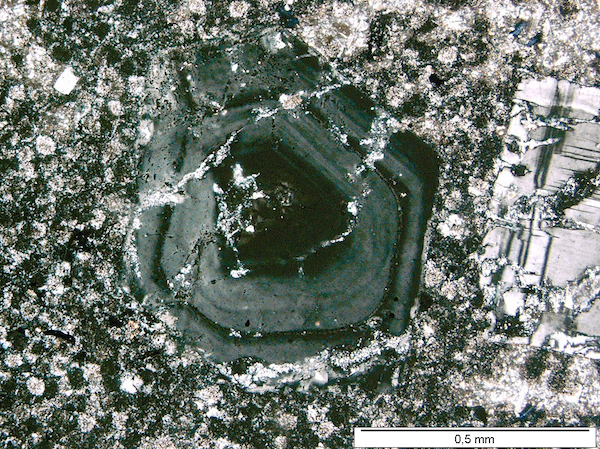
Discontinuous Series
Olivine begins to form at just below 1300°C, but as the temperature drops, olivine becomes unstable. The early-forming olivine crystals react with silica in the remaining liquid and are converted into pyroxene, something like this:
As long as silica remains and cooling is slow, this process continues down the discontinuous branch: olivine reacts to form pyroxene, and pyroxene reacts to form amphibole. Under the right conditions amphibole will form to biotite. Finally, if the magma is quite silica-rich to begin with, there will still be some silica left at around 750 °C to 800 °C. From this last magma, potassium feldspar, quartz, and possibly muscovite mica will form.
Notice that the sequence of minerals that form goes from isolated tetrahedra (olivine) toward increasingly complex arrangements of silica tetrahedra. Pyroxene consists of single chains, amphibole has double chains, mica has sheets of tetrahedra, and potassium feldspar and quartz at the bottom of the series have tetrahedra connected to each other in three dimensions.
If the magma cools enough, the first minerals to form will be completely used up in later chemical reactions. This is why igneous rocks don’t normally have both olivine (at the top of the series) and quartz (at the bottom). Exceptions can occur when rocks that crystallized early in the series come into contact with magmas representing compositions later in the series, such as with the dark green olivine-rich xenoliths included within the quartz- and feldspar-rich rock in Figure 7.10. The dark line around the xenoliths is amphibole, which formed as the olivine reacted with the melt. In some of the smaller xenoliths within this boulder, the olivine has been completely transformed into amphibole.
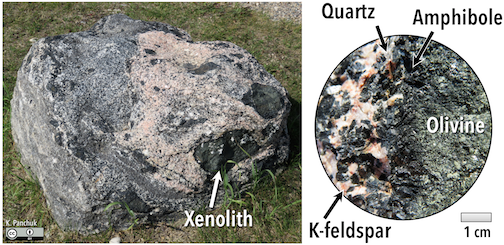
The Original Magma Composition Matters
The composition of the original magma determines how far the reaction process can continue before all of the magma is used up. In other words, it determines which minerals will form.
In mafic magmas, some of the silica combines with iron and magnesium to make olivine. As it cools further, much of the remaining silica goes into calcium-rich plagioclase, and any silica left may be used to convert some of the olivine to pyroxene. Soon after that, all of the magma is used up and no further changes takes place. The minerals present will be olivine, pyroxene, and calcium-rich plagioclase.
Felsic magmas tend to be cooler than mafic magmas when crystallization begins, because they don’t have to be as hot to remain liquid. They may start out crystallizing pyroxene (not olivine) and plagioclase. As cooling continues, the various reactions on the discontinuous branch will proceed because silica is abundant, and eventually potassium feldspar and quartz will form. Tthe plagioclase will become increasingly sodium-rich. Even very felsic rocks may not have biotite or muscovite if they don’t have enough aluminum or hydrogen to make the OH complexes that are necessary for mica minerals.
Fractional Crystallization Also Makes Magma Richer In Silica
A magma chamber is a space within the Earth that’s filled with molten rock. If the magma in a magma chamber has a low viscosity—meaning it flows easily, which is likely if the magma is mafic—the crystals that form early, such as olivine (Figure 7.11a), may slowly settle toward the bottom of the magma chamber (Figure 7.11b). This process is called fractional crystallization.
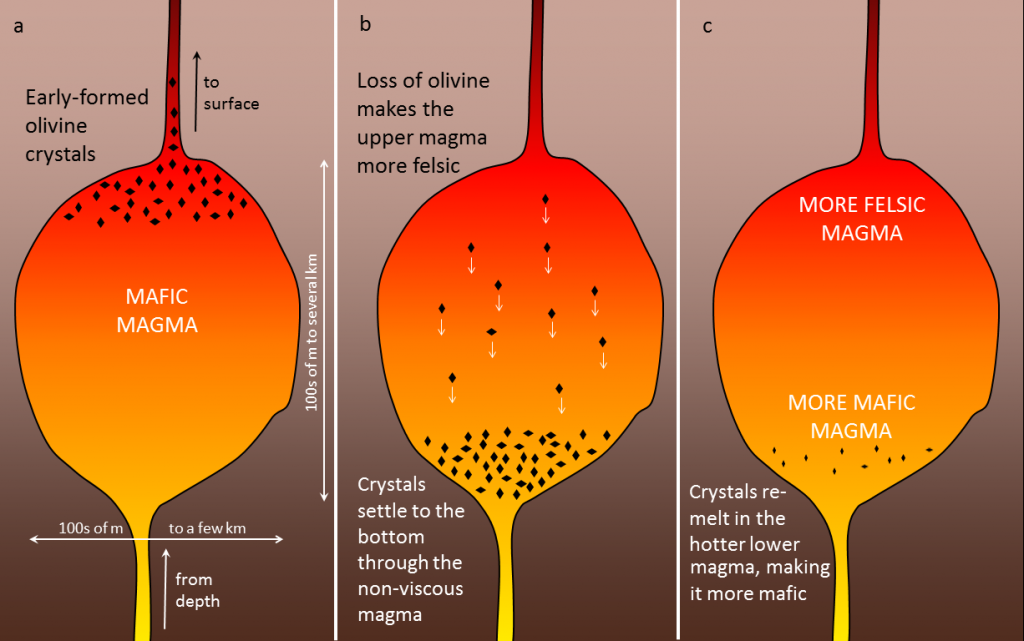
When olivine forms, it takes iron- and magnesium-rich components out of the magma, leaving the overall composition of the magma near the top of the magma chamber more felsic. The crystals that settle may form an olivine-rich layer near the bottom of the magma chamber. Alternatively, because the lower part of the magma chamber is likely to be hotter than the upper part, the crystals might remelt. If remelting happens, the magma at the bottom of the chamber will have the iron- and magnesium-rich components added back, making it more mafic than it was to begin with (Figure 7.11c).
Mixing In Other Material
Magma chambers aren’t isolated from their surroundings. If the rock in which the magma chamber is located (called the country rock) is more felsic than the magma, the country rock may also melt, adding to the magma already in the magma chamber (Figure 7.12). Sometimes magma carries fragments of unmelted rock, called xenoliths, within it. Melting of xenoliths can also alter the composition of magma, as can re-melting of crystals that have settled out of the magma.
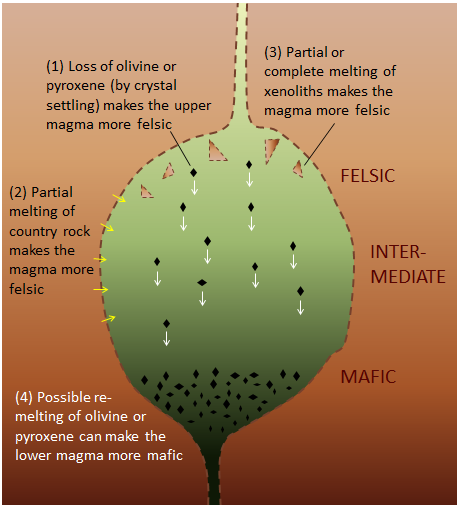
- The komatiites of the Song Da zone in northwestern Vietnam are 270 million years old, and those on Gorgona Island, Columbia are 89 million years old. Exactly how they formed is still a bit of a mystery. See Table 1 of arXiv:physics/0512118v2 [physics.geo-ph] for a compilation of komatiite ages with references. ↵


